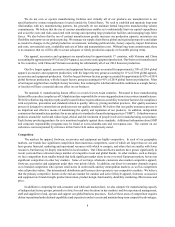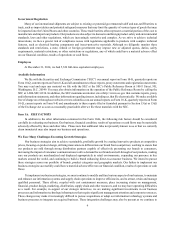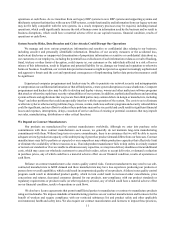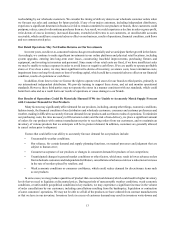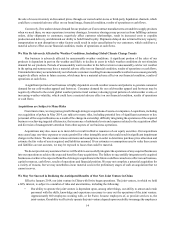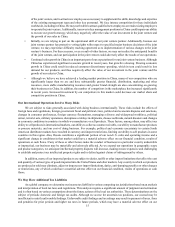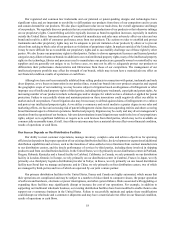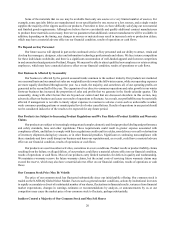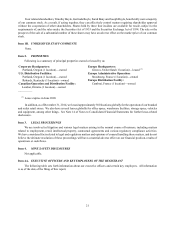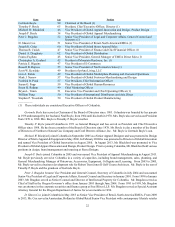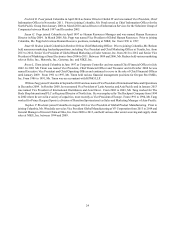Columbia Sportswear 2014 Annual Report Download - page 22
Download and view the complete annual report
Please find page 22 of the 2014 Columbia Sportswear annual report below. You can navigate through the pages in the report by either clicking on the pages listed below, or by using the keyword search tool below to find specific information within the annual report.18
Our registered and common law trademarks and our patented or patent-pending designs and technologies have
significant value and are important to our ability to differentiate our products from those of our competitors and to create
and sustain demand for our products. We also place significant value on our trade dress, the overall appearance and image
of our products. We regularly discover products that are counterfeit reproductions of our products or that otherwise infringe
on our proprietary rights. Counterfeiting activities typically increase as brand recognition increases, especially in markets
outside the United States. Increased instances of counterfeit manufacture and sales may adversely affect our sales and our
brand and result in a shift of consumer preference away from our products. The actions we take to establish and protect
trademarks and other proprietary rights may not be adequate to prevent imitation of our products by others or to prevent
others from seeking to block sales of our products as violations of proprietary rights. In markets outside of the United States,
it may be more difficult for us to establish our proprietary rights and to successfully challenge use of those rights by other
parties. We also license our proprietary rights to third parties. Failure to choose appropriate licensees and licensed product
categories may dilute or harm our brands. In addition to our own intellectual property rights, many of the intellectual property
rights in the technology, fabrics and processes used to manufacture our products are generally owned or controlled by our
suppliers and are generally not unique to us. In those cases, we may not be able to adequately protect our products or
differentiate their performance characteristics and fabrications from those of our competitors. The management of our
intellectual property portfolio may affect the strength of our brands, which may in turn have a material adverse effect on
our financial condition, results of operations or cash flows.
Although we have not been materially inhibited from selling products in connection with patent, trademark and trade
dress disputes, as we focus on innovation in our product lines, extend our brands into new product categories and expand
the geographic scope of our marketing, we may become subject to litigation based on allegations of infringement or other
improper use of intellectual property rights of third parties, including third party trademark, copyright and patent rights. An
increasing number of our products include technologies and/or designs for which we have obtained or applied for patent
protection. Failure to successfully obtain and maintain patents on these innovations could negatively affect our ability to
market and sell our products. Future litigation also may be necessary to defend against claims of infringement or to enforce
and protect our intellectual property rights. As we utilize e-commerce and social media to a greater degree in our sales and
marketing efforts, we face an increasing risk of patent infringement claims from non-operating entities and others covering
broad functional aspects of internet operations. Intellectual property litigation may be costly and may divert management’s
attention from the operation of our business. Adverse determinations in any litigation may result in the loss of our proprietary
rights, subject us to significant liabilities or require us to seek licenses from third parties, which may not be available on
commercially reasonable terms, if at all. Any of these outcomes may have a material adverse effect on our financial condition,
results of operations or cash flows.
Our Success Depends on Our Distribution Facilities
Our ability to meet customer expectations, manage inventory, complete sales and achieve objectives for operating
efficiencies depends on the proper operation of our existing distribution facilities, the development or expansion of additional
distribution capabilities and services, such as the transition of value-added services functions from contract manufacturers
to our distribution centers, and the timely performance of services by third parties, including those involved in shipping
product to and from our distribution facilities. In the United States, we rely primarily on our distribution centers in Portland,
Oregon, Robards, Kentucky and a leased facility in Carlsbad, California; in Canada, we rely primarily on our distribution
facility in London, Ontario; in Europe, we rely primarily on our distribution center in Cambrai, France; in Japan, we rely
primarily on a third-party logistics distribution provider in Tokyo; in Korea, we rely primarily on one leased distribution
facility near Seoul that we manage and operate; and in China, we rely primarily on four distribution centers, two of which
are managed by third-parties and two of which are operated by our joint venture partner.
Our primary distribution facilities in the United States, France and Canada are highly automated, which means that
their operations are complicated and may be subject to a number of risks related to computer viruses, the proper operation
of software and hardware, electronic or power interruptions, and other system failures. Risks associated with upgrading or
expanding these facilities may significantly disrupt or increase the cost of our operations. For example, in addition to
supporting our traditional wholesale business, our existing distribution facilities have been modified to enable them to also
support our e-commerce business in the United States. Failure to successfully maintain and update these modifications
could disrupt our wholesale and e-commerce shipments and may have a material adverse effect on our financial condition,
results of operations or cash flows.


